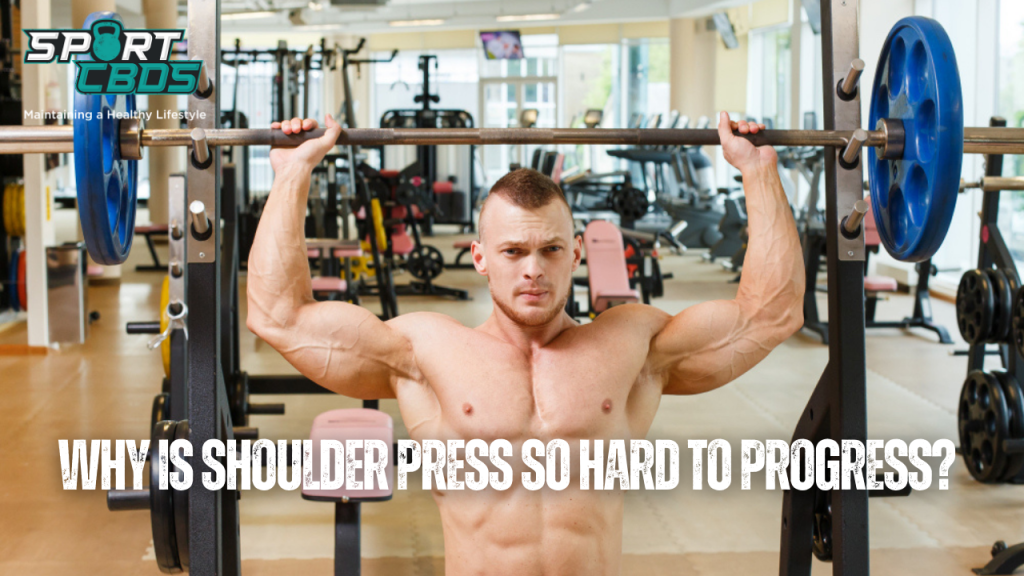
Why Is Shoulder Press So Hard To Progress? 7 Fixes for Progression
Shoulder press, also known as overhead press or military press, is a popular exercise for building upper body strength. However, many people struggle to progress in this exercise over a long period of time.
This can be frustrating and demotivating, especially when other exercises such as bench press seem to progress more easily. In this post, we will explore the reasons why shoulder press can be so hard to progress and provide tips on how to improve your performance.
Why Is Shoulder Press So Hard To Progress?
Shoulder press, also known as overhead press or military press, is often challenging to progress due to several factors, including the resistance and complexity of the movement, individual factors, and smaller supporting muscles involved. Unlike the bench press, which primarily relies on the larger chest muscles, shoulder press heavily depends on the smaller muscles of the shoulders and upper back. These muscles require more training volume and intensity to grow and strengthen. Additionally, the complexity of the movement demands proper form and technique to avoid injury and maximize muscle activation. Even slight deviations from correct form can lead to decreased effectiveness or injury. Individual factors, such as muscle imbalances, previous injuries, or poor posture, can also impact one’s ability to progress in the shoulder press. For example, weak posterior shoulder muscles or scapula instability can hinder maintaining proper form throughout the exercise, limiting the ability to lift heavier weights over time.
Resistance and Complexity
One reason why shoulder press can be difficult to progress is the resistance involved in the movement. Unlike bench press, which uses the chest muscles as the primary movers, shoulder press relies heavily on the smaller muscles of the shoulders and upper back. These muscles are not as strong as the chest muscles and require more training volume and intensity to grow.
Another factor that contributes to slow progress in shoulder press is the complexity of the movement itself. Proper form and technique are crucial for avoiding injury and maximizing muscle activation. The slightest deviation from correct form can lead to decreased effectiveness or even injury.
Individual Factors
In addition to resistance and complexity, individual factors such as muscle imbalances or previous injuries can also impact one’s ability to progress in shoulder press.
For example, if your posterior shoulder muscles are weak or you have instability issues with your scapula (shoulder blades), you may struggle with maintaining proper form throughout each rep.
Furthermore, poor posture or stress-related tension in your upper back can limit your range of motion during overhead movements like shoulder press. This makes it harder for you to lift heavier weights over time.
Reasons Why Your Overhead Press is Weak and How to Fix It
Poor Shoulder Mobility Can Lead to a Weak Overhead Press
One of the most common reasons why your overhead press is weak is due to poor shoulder mobility. The overhead press requires a great deal of range of motion in the shoulder joint, and if you lack this flexibility, it can be challenging to perform the exercise correctly.
To improve your shoulder mobility, incorporate exercises that target the posterior shoulder muscles such as face pulls or band pull-aparts. Additionally, stretching exercises such as doorway stretches or sleeper stretches can help increase your range of motion over time.
Weak Core and Lower Body Muscles Can Also Contribute to a Weak Overhead Press
Another reason why your overhead press may be weak is due to a lack of strength in your core and lower body muscles. A strong core provides stability during the lift, while strong legs provide a stable base for you to push from.
Incorporate exercises such as planks or deadlifts into your workout program to strengthen your core and lower body muscles. This will not only improve your overhead press but also benefit other compound lifts like the bench press or squat.
Incorrect Form and Technique Can Hinder Progress in the Overhead Press
Using incorrect form and technique during an overhead press can lead to injury and hinder progress in the long run. Common mistakes include arching the back excessively, flaring out elbows too much, or not keeping a tight grip on the barbell.
To ensure proper form during an overhead press, start with lighter weights and focus on correct posture throughout each rep. Keep elbows tucked in slightly towards the body, maintain neutral spine alignment, and engage core muscles throughout each rep.
Lack of Consistency in Training and Not Progressively Overloading Can Also Result in a Weak Overhead Press
If you’re not consistently training your shoulders with enough volume or intensity, progress will be slow or nonexistent. Additionally, failing to progressively overload by increasing weight load over time can limit strength gains.
To improve your overhead press, incorporate it into your training program at least once a week and track progress by keeping a training log. Gradually increase the weight load over time, aiming for the minimum effective dose to avoid injury or burnout.
Not Incorporating Accessory Exercises Such as Lateral Raises and Tricep Extensions Can Limit Progress in the Overhead Press
Incorporating accessory exercises such as lateral raises or tricep extensions can help strengthen smaller muscles that contribute to an overhead press. Neglecting these exercises can limit progress in the long run.
Include exercises that target shoulder muscles such as lateral raises or face pulls, along with tricep extensions to strengthen the arms. This will help improve overall upper body strength and lead to better performance in the overhead press.
Inadequate Recovery and Nutrition Can Also Affect Strength Gains in the Overhead Press
Lastly, inadequate recovery and nutrition can affect strength gains in the overhead press. Without proper rest and fuel for your body, you won’t be able to perform at your best during workouts.
Ensure adequate rest days between workout sessions and prioritize nutrition by consuming enough protein, carbohydrates, and healthy fats. This will provide your body with sufficient energy to perform well during workouts while promoting muscle growth and repair.

Military Press vs. Overhead Press: Which Exercise Should You Do?
Military press and overhead press are two of the most popular choices. Both exercises target the same muscle groups, but with slight variations in technique and muscle activation. In this section, we’ll discuss the differences between these two exercises and which one you should do based on your fitness goals.
Overhead Press
The overhead press is a more general term that encompasses different variations such as strict overhead press, push press, and jerk. This exercise involves lifting a weight overhead using your shoulders and triceps while standing or seated. The strict overhead press is performed without any leg drive, while push press and jerk involve using leg drive to lift heavier weights.
The overhead press is an effective exercise for developing shoulder strength and size compared to bench press, which primarily targets the chest muscles. It also engages other upper body muscles such as the triceps, upper back, and core for stability during the lift.
Military Press
The military press refers specifically to a strict overhead press without leg drive. This exercise requires greater stability and control than other variations of overhead presses since there’s no momentum from the legs to assist in lifting the weight.
Military presses are considered more challenging than other types of presses because they require more strength in the shoulders and triceps. They’re also beneficial for improving posture since they target the posterior shoulder muscles that help stabilize your scapulae.
Pin Press
Pin press is a useful accessory exercise for improving lockout strength in overhead presses. It allows you to overload the top portion of the lift where you’re weakest by setting up pins at various heights in a power rack or squat rack.
To perform pin presses correctly, set up pins at chest height or slightly above it so that when you unrack the barbell from them, it’s at your sticking point – usually around forehead level. Then lower it down until it touches the pins, pause for a second, and press it back up.
Proper Form
To lift the most weight in overhead presses, you need to have a solid foundation of strength in your shoulders, triceps, upper back, and core. You also need good technique and proper programming to avoid injury and make progress over time.
One common mistake many lifters make is not using their legs during the lift. While strict overhead presses don’t allow leg drive, push press and jerk do. Using your legs can help you lift heavier weights by generating more power from the ground up.
Another mistake is not maintaining proper form throughout the movement. Your starting position should be with your wrists straight and elbows slightly forward of the barbell. As you press the weight overhead, keep your head neutral and shoulder blades retracted to avoid shoulder impingement issues.
Related: Why Are My Shoulders So Narrow?
Strengthening the Shoulders
Strengthening the shoulder muscles to improve overall shoulder strength is important for weight lifters and anyone who wants to improve their upper body strength.
Compound exercises like shoulder press, push-ups, and bench press are effective in building strong shoulders. These exercises work multiple muscle groups at once, including the chest, triceps, and anterior deltoids.
Isolation exercises like lateral raises and front raises can target specific areas of the shoulder muscles. These exercises isolate the smaller muscles in the shoulders, such as the medial deltoids and rotator cuff muscles.
Incorporating both compound and isolation exercises into your workout program can help you achieve a well-rounded shoulder workout.
Impingement
Proper form and technique are crucial in preventing shoulder impingement during shoulder exercises. Shoulder impingement occurs when there is pressure on the rotator cuff tendons or bursa as they pass through a narrow space under the acromion bone of the shoulder blade. This can lead to pain and weakness in the shoulders over time.
To prevent shoulder impingement during your workouts, it’s important to maintain good posture throughout each exercise. Keep your shoulders down and back, away from your ears, to avoid unnecessary stress on your neck and upper back muscles.
Additionally, focus on keeping your elbows close to your body during pressing movements like bench press or overhead press.
Posterior Shoulder and Rotator Cuff Muscles
Strengthening the posterior shoulder and rotator cuff muscles can improve shoulder stability and prevent injuries. The posterior deltoid is often neglected in many training programs but plays an important role in maintaining proper posture by pulling your shoulders back into a neutral position.
Incorporating bodyweight exercises like planks and push-ups can also help strengthen the shoulders and shoulder blades. These exercises require no equipment but still provide a challenging workout for your upper body.
It’s important to start with a weight that is appropriate for your fitness level and gradually increase the load over time. Focus on correct form and posture during each exercise to avoid injury.
Programming
When programming your shoulder workout, it’s important to focus on proper form and technique rather than just lifting heavier weights. Incorporating smaller changes like grip width or rep ranges can also help you make progress over time without risking injury or burnout.
If you’re experiencing pain or weakness in your shoulders during workouts, it may be due to weak shoulder mobility or instability. Incorporating exercises that target these areas can help improve your range of motion and reduce risk of injury.
Building Scapular Stabilisers and Triceps
Scapular stabilisers and triceps are two muscle groups that are crucial for a successful shoulder workout program. The scapula is the bone that connects the upper arm bone (humerus) with the collarbone (clavicle).
Scapular stabilisers play a vital role in maintaining proper form and preventing injury during overhead press exercises, such as military press or strict overhead press.
Instability and Poor Posture
One common mistake many lifters make is neglecting to strengthen their scapular stabilizers. Weak scapular muscles can lead to instability and poor posture during pressing movements, which can increase the risk of injury over time.
To build strong scapular stabilizers, it’s important to incorporate exercises such as scapular retractions and wall slides into your training routine.
Scapular retractions involve pulling the shoulder blades together while keeping the arms straight, while wall slides require sliding your hands up a wall while keeping your elbows and wrists in contact with the wall at all times.
Both of these exercises help activate and strengthen the muscles responsible for maintaining proper scapular position during overhead press movements.
Importance of Triceps
Triceps are another important muscle group involved in shoulder press exercises. They assist with elbow extension and contribute to overall pushing power during lifts like military press or bench press. Neglecting tricep strength can limit progress on these lifts over time.
To improve tricep strength, isolation exercises such as tricep extensions should be incorporated into your training program. These can be done using dumbbells or cables, and variations include overhead extensions or skull crushers. Gradually increasing weight and reps over time will help build tricep strength and support progress on overhead pressing movements.
It’s important to note that building strong shoulders involves more than just working on overhead presses alone. Incorporating compound lifts that engage multiple muscle groups, such as pull-ups or rows, can also help develop upper back muscles that support good posture during pressing movements.
Mobility and Stability
Additionally, focusing on mobility and stability in the shoulder joint can help prevent injury and improve overall performance. Exercises such as band pull-aparts or rotator cuff exercises can help improve shoulder mobility and reduce the risk of shoulder impingement.
When programming your shoulder workout, it’s important to consider factors such as exercise selection, volume, intensity, and frequency. The minimum effective dose for building strength is typically around 3-4 sets of 6-8 reps per exercise, with a weight that challenges you but allows for proper form.
Small Changes
Small changes to your training program over time can also lead to big improvements in overhead press performance. For example, changing grip width or incorporating pin presses (starting the lift from a rack position) can help address weak points in the lift and increase load over time.
Keeping a training log can also be helpful for tracking progress and making adjustments to your program as needed. Remember to focus on proper form and technique above all else when lifting weights – heavier weights will come with time and practice.
Lat Stretch with Band: Improving Shoulder Mobility
Using a band for lat stretching can help improve shoulder mobility, which is crucial for proper shoulder press form. Shoulder mobility is essential to maintain proper posture and form during overhead presses such as the military press or shoulder press. Poor mobility in the shoulders can lead to poor form, which increases the risk of injury and reduces progress.
Improved back mobility from lat stretching can also aid in maintaining a stable bar path during the lift. The bar should move in a straight line above your head when performing an overhead press. Any deviation from this path will reduce efficiency and increase the risk of injury.
Incorporating hip movement into the stretch can further enhance overall mobility and range of motion. Tight hips can affect your posture and limit your ability to perform compound lifts such as squats, deadlifts, and overhead presses. Stretching with bands can help loosen up tight hips, leading to better overall mobility.
Wider Stance for Stable Base
A wider stance in the rack position can provide more stability during the lift, allowing for better control of the movement. Stability is essential when performing any exercise that involves lifting weights over your head. A wider stance will give you a more stable base, reducing the risk of injury.
Performing the shoulder press through a full range of motion can be challenging, but proper mobility work with bands can help achieve this. Full range of motion means lowering the weight all the way down until it touches your upper chest before pressing it back up again. This requires good flexibility in both shoulders and elbows.
Training With bands
Varying grip width and incorporating some instability training with bands can also aid in improving shoulder and lower body mobility for the lift. Changing grip width changes how much emphasis is placed on different muscle groups during an exercise; therefore, varying grip width will allow you to target different areas of your shoulders while still working towards improved mobility.
One common mistake many lifters make is neglecting their upper back muscles. The upper back muscles play a vital role in maintaining good posture and form during overhead presses. Neglecting these muscles can lead to poor posture, which reduces the effectiveness of the exercise.
The rotator cuff muscles are small muscles that help stabilize the shoulder joint during overhead movements. Neglecting these muscles can increase the risk of shoulder impingement or other issues that limit progress. Therefore, it’s important to include exercises that target these smaller muscles in your workout program.
Incorporating resistance bands into your training program can be an effective way to improve mobility while reducing stress on your joints. Resistance bands offer a safer alternative to free weights for those who are new to weight lifting or have existing injuries.
Shoulder Workout For Progression
Warm-up:
- 5-10 minutes of light cardio (jogging, jump rope, or cycling)
- Dynamic stretches targeting the upper body (arm circles, shoulder rolls, and cross-body arm swings)
Workout:
- Standing Military Press (compound lift)
- 3-4 sets of 6-8 reps
- Start with a weight that is challenging but allows for proper form
- Dumbbell Lateral Raises (isolation exercise)
- 3-4 sets of 10-12 reps
- Focus on maintaining strict form and posture
- Scapular Retractions (scapular stabiliser exercise)
- 3 sets of 10-12 reps
- Use a resistance band or a light weight
- Wall Slides (scapular mobility exercise)
- 3 sets of 10-12 reps
- Keep your elbows and wrists in contact with the wall at all times
- Band Pull-Aparts (rotator cuff exercise)
- 3 sets of 12-15 reps
- Use a resistance band with a light to moderate resistance
- Tricep Extensions (isolation exercise)
- 3-4 sets of 8-10 reps
- Choose a variation (dumbbell or cable, overhead extensions or skull crushers)
- Plank (core stability and shoulder strength)
- 3 sets, hold for 30-60 seconds each
- Focus on maintaining a straight line from head to heels
Cool-down:
- 5 minutes of light cardio to lower heart rate (walking or cycling)
- Static stretches targeting the upper body (chest, shoulders, triceps, and lats)
Related: Do Lateral Raises Work the Traps as Well as Shoulders?
FAQs
Why can’t I progress on dumbbell shoulder press?
A lack of progress in the dumbbell shoulder press can be attributed to several factors, including improper form, muscle imbalances, inadequate mobility, and insufficient training volume or intensity. Addressing these issues through targeted exercises, proper technique, and gradual increases in weight and reps can help improve progress.
How do you progressively overload shoulder press?
Progressive overload can be achieved in the shoulder press by gradually increasing the weight, number of reps, or sets over time. Other strategies include adjusting grip width, implementing paused reps, and varying the tempo. Always prioritize proper form and technique to avoid injury and ensure effective progression.
Why does overhead press progress slow?
Overhead press progress can be slow due to the complexity of the movement, the involvement of smaller muscle groups, and the need for precise form and stability. Focusing on strengthening the rotator cuff, triceps, and scapular stabilizers, as well as improving mobility and form, can help accelerate progress in the overhead press.
What is a progression of a shoulder press?
A progression of a shoulder press involves moving from simpler, less demanding exercises to more complex, challenging ones as strength and technique improve. For example, one might start with seated dumbbell presses and progress to standing dumbbell presses, barbell shoulder presses, and ultimately, the strict overhead press.
How much shoulder press is impressive?
An impressive shoulder press varies depending on an individual’s body weight, experience, and fitness level. However, a general benchmark for a strong shoulder press is lifting a weight equivalent to your body weight or more. Keep in mind that individual capabilities may vary, and personal progress should be the primary focus.
How much should I be able to do on shoulder press?
The amount you should be able to shoulder press depends on factors such as your body weight, experience, and fitness level. As a rough guideline, beginners can aim to press around 50-60% of their body weight, while more experienced lifters might target 75-100% or more. Focusing on consistent progress and proper form is more important than comparing yourself to others.
Final Thoughts…
In conclusion, many lifters face challenges in progressing their shoulder press due to a combination of common mistakes, muscle imbalances, and technique issues. Ensuring proper activation of the shoulder blades, rotator cuff muscles, and triceps is crucial for a strong overhead press movement.
Incorporating a well-rounded workout program that includes compound exercises, mobility work, and targeted strengthening can help address these weaknesses and improve progress in overhead presses like the military press and strict overhead press.
Focusing on correct form, gradually increasing load and volume, and maintaining stability throughout the movement, particularly in the rack position, can enhance performance in this compound lift. A wider stance, full range of motion, and attention to grip adjustments can further contribute to better results.
Regularly reviewing your training log and making small changes to your workout program will allow you to address any pain or mobility issues, leading to stronger shoulders and overall improved performance.
By understanding the reasons behind weak overhead press performance and adhering to the basic principles of effective training, lifters can unlock their potential and experience greater progress in this challenging, yet rewarding exercise.
Do you find the shoulder press is hard to progress and have these tips helped? Let me know in the comments section below.
If you enjoy sports and use CBD to help with your recovery in between gruelling workouts, then you are in the right place. Here at Sport CBDs, we train hard and recover the best way possible…
We have regular workouts (check out the YouTube channel), CBD news and CBD products to help you gain that edge!
If you wanted to check out the reputable CBD we have on offer here at the site, then please head to the Sport CBDs Store (CLICK HERE). We also do fitness clothing and yoga accessories too.
Until next time, all the best…
Lee
Founder – Sport CBDs
Featured Image Attribution – Image by Racool_studio on Freepik



It’s amazing to go to see this site and reading the views of all colleagues concerning this post, while I am also zealous off getting familiarity.